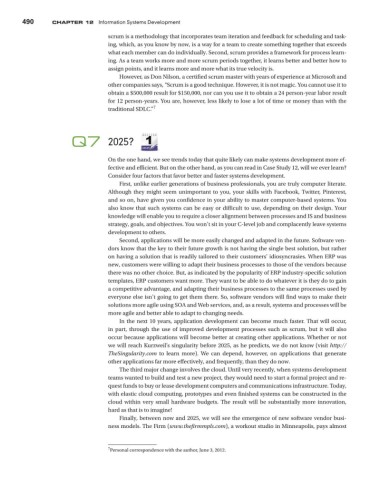Page 522 - Using MIS
P. 522
490 Chapter 12 Information Systems Development
scrum is a methodology that incorporates team iteration and feedback for scheduling and task-
ing, which, as you know by now, is a way for a team to create something together that exceeds
what each member can do individually. Second, scrum provides a framework for process learn-
ing. As a team works more and more scrum periods together, it learns better and better how to
assign points, and it learns more and more what its true velocity is.
However, as Don Nilson, a certified scrum master with years of experience at Microsoft and
other companies says, “Scrum is a good technique. However, it is not magic. You cannot use it to
obtain a $500,000 result for $150,000, nor can you use it to obtain a 24 person-year labor result
for 12 person-years. You are, however, less likely to lose a lot of time or money than with the
traditional SDLC.” 7
Q7 2025?
On the one hand, we see trends today that quite likely can make systems development more ef-
fective and efficient. But on the other hand, as you can read in Case Study 12, will we ever learn?
Consider four factors that favor better and faster systems development.
First, unlike earlier generations of business professionals, you are truly computer literate.
Although they might seem unimportant to you, your skills with Facebook, Twitter, Pinterest,
and so on, have given you confidence in your ability to master computer-based systems. You
also know that such systems can be easy or difficult to use, depending on their design. Your
knowledge will enable you to require a closer alignment between processes and IS and business
strategy, goals, and objectives. You won’t sit in your C-level job and complacently leave systems
development to others.
Second, applications will be more easily changed and adapted in the future. Software ven-
dors know that the key to their future growth is not having the single best solution, but rather
on having a solution that is readily tailored to their customers’ idiosyncrasies. When ERP was
new, customers were willing to adapt their business processes to those of the vendors because
there was no other choice. But, as indicated by the popularity of ERP industry-specific solution
templates, ERP customers want more. They want to be able to do whatever it is they do to gain
a competitive advantage, and adapting their business processes to the same processes used by
everyone else isn’t going to get them there. So, software vendors will find ways to make their
solutions more agile using SOA and Web services, and, as a result, systems and processes will be
more agile and better able to adapt to changing needs.
In the next 10 years, application development can become much faster. That will occur,
in part, through the use of improved development processes such as scrum, but it will also
occur because applications will become better at creating other applications. Whether or not
we will reach Kurzweil’s singularity before 2025, as he predicts, we do not know (visit http://
TheSingularity.com to learn more). We can depend, however, on applications that generate
other applications far more effectively, and frequently, than they do now.
The third major change involves the cloud. Until very recently, when systems development
teams wanted to build and test a new project, they would need to start a formal project and re-
quest funds to buy or lease development computers and communications infrastructure. Today,
with elastic cloud computing, prototypes and even finished systems can be constructed in the
cloud within very small hardware budgets. The result will be substantially more innovation,
hard as that is to imagine!
Finally, between now and 2025, we will see the emergence of new software vendor busi-
ness models. The Firm (www.thefirmmpls.com), a workout studio in Minneapolis, pays almost
7 Personal correspondence with the author, June 3, 2012.

